Standard [CURRENT]
ASTM E 1859/E 1859M:2024
Standard Test Method for Friction Coefficient Measurements Between Tire and Pavement Using a Variable Slip Technique
- Publication date
- 2024
- Original language
- English
- Pages
- 8
- Publication date
- 2024
- Original language
- English
- Pages
- 8
- DOI
- https://dx.doi.org/10.1520/E1859_E1859M-24
Product information on this site:
Quick delivery via download or delivery service
Buy securely with a credit card or pay upon receipt of invoice
All transactions are encrypted
Short description
1.1 This test method covers the measurement of the longitudinal friction coefficient with a measurement device that imposes braking slip between a tire and a surface for the full range of braking slip speed values. 1.2 This test method utilizes a series of incremental single measurements of friction force on a braked test wheel as it is pulled over a wetted or contaminated pavement surface. The rotational velocity of the braked wheel is feedback controlled in order to give a predetermined variable slip ratio gradient in accordance with set program parameters. The test wheel is kept under a constant static normal load and at a constant longitudinal speed of travel. Its major plane is perpendicular to the road plane and parallel to its direction of motion. 1.3 The values measured represent the friction properties obtained with the equipment and procedures stated in this test method and do not necessarily agree or correlate directly with those obtained by other pavement friction measuring methods. 1.4 The values are intended for use in: 1.4.1 Evaluating the braking friction forces on a pavement relative to that of other pavements. 1.4.2 Evaluating changes in the braking friction forces of a particular pavement with the passage of time. 1.4.3 Evaluating the changes in the braking friction force of a pavement when subjected to polishing wear and loss of macrotexture caused by traffic with passage of time. 1.4.4 Evaluating changes in the braking friction forces of a pavement contaminated with ice, moderate amounts 2 of slush and snow, pollen, vehicle oil spills and condensates from vehicle engine exhaust, and deposits from other pollution sources. 1.4.5 Evaluating the braking friction forces of a specimen tire on a clean or contaminated pavement. 1.5 The friction values reported by this test method are insufficient to determine the distance required to stop a vehicle on either a dry, wet, or contaminated pavement. They are also insufficient for determining the speed at which control of a vehicle would be lost. 1.6 The values stated in either SI units or inch-pound units are to be regarded separately as standard. The values stated in each system may not be exact equivalents; therefore, each system shall be used independently of the other. Combining values from the two systems may result in nonconformance with the standard. 1.7 This standard does not purport to address all of the safety concerns, if any, associated with its use. It is the responsibility of the user of this standard to establish appropriate safety, health, and environmental practices and determine the applicability of regulatory limitations prior to use. Specific precautionary statements are given in Section 6 and Note 4 . 1.8 This international standard was developed in accordance with internationally recognized principles on standardization established in the Decision on Principles for the Development of International Standards, Guides and Recommendations issued by the World Trade Organization Technical Barriers to Trade (TBT) Committee.
ICS
83.160.01,
93.080.99
DOI
https://dx.doi.org/10.1520/E1859_E1859M-24
Also available in
Loading recommended items...
Loading recommended items...
Loading recommended items...
Loading recommended items...

